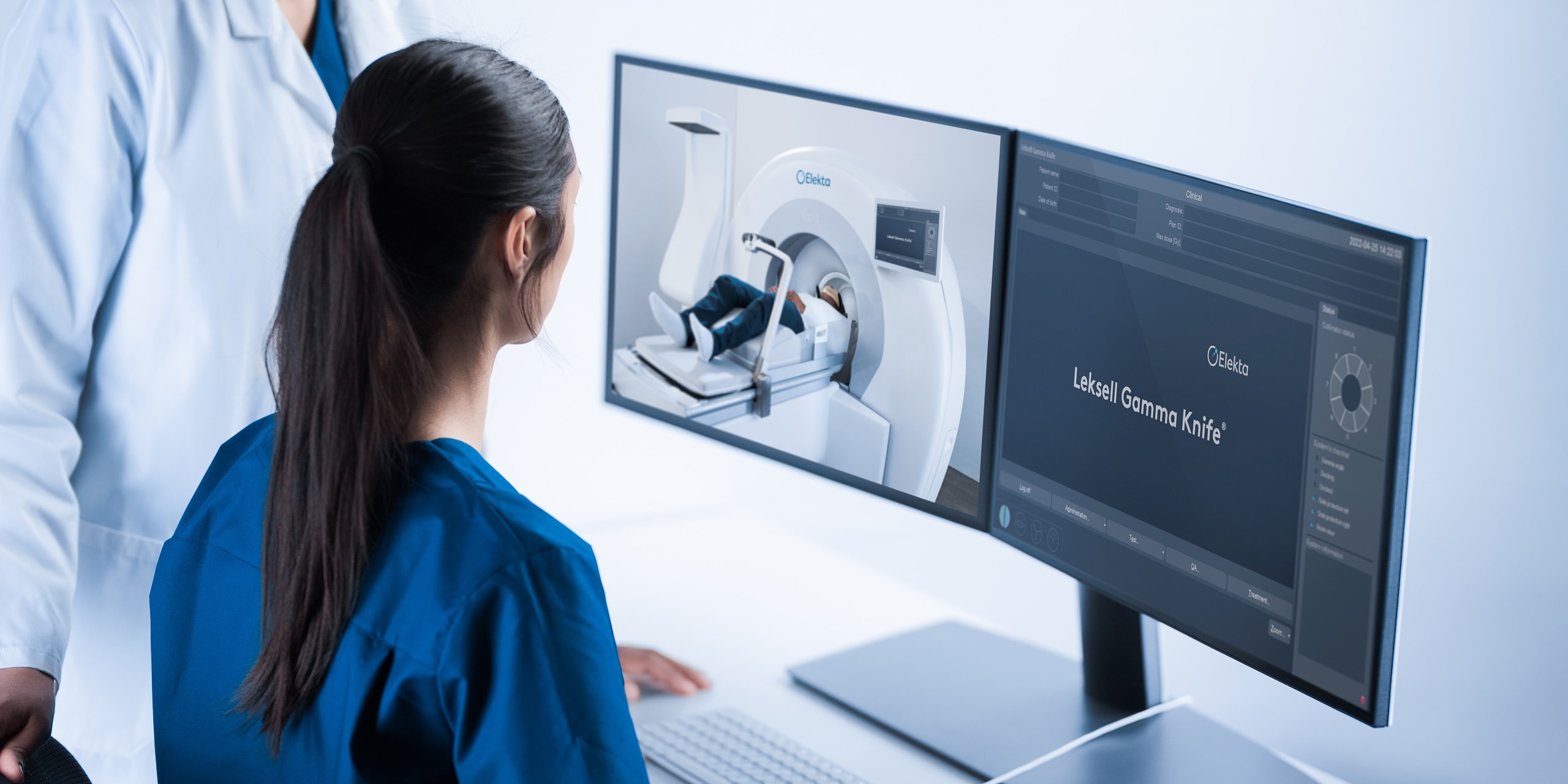
Image courtesy of Elekta
Author: Steven Seung, M.D., Ph.D., FACR, radiation oncologist, Elsie Franz Finley Radiation Oncology Center, Providence Cancer Institute, and The Oregon Clinic Radiation Oncology
Key takeaways
- The Gamma Knife Center at Providence upgraded its Gamma Knife system to Esprit.
- Gamma Knife is a noninvasive, outpatient procedure to treat cancerous and noncancerous conditions of the brain.
- With Esprit, patients can wear a thermoplastic mask during treatment, rather than a fixed headframe, if appropriate.
- Providence is a leader in offering state-of-the-art radiotherapies to patients in Oregon.
This fall, Providence Gamma Knife Center of Oregon unveiled an upgrade to its Gamma Knife system. Building on the precision of its predecessor, Perfexion, the Esprit stereotactic radiosurgery system targets the most challenging areas of the brain with exceptional accuracy while also reducing anxiety and discomfort for patients with cancerous and noncancerous conditions.
Where the Perfexion model uses a headframe with pins that affix to the patient’s skull, Esprit allows for a thermoplastic mask in many cases. Constructed of plastic mesh, the mask is custom-made to precisely fit the patient’s face. During treatment, the mask holds the patient’s head in place, assuring accuracy during radiosurgery. For many patients, the option to use a mask reduces both physical and psychological discomfort during treatment.
Providence Gamma Knife Center of Oregon, a service of Providence Brain and Spine Institute and Providence Cancer Institute, was the first center in Oregon to adopt Gamma Knife. Now, we are the first center in Oregon to upgrade our stereotactic radiosurgery system to Esprit. This is especially exciting and it reflects Providence’s commitment to innovation in radiotherapy.
What is Gamma Knife?
Swedish physician Lars Leksel with physicist and radiobiologist Borje Larsson began exploring radiosurgery technology in the 1950s, in search of a new tool for performing neurosurgery. After several iterations of radiosurgery devices, Gamma Knife was created and today it remains the most established noninvasive surgical procedure for treating brain conditions and diseases.
Gamma Knife uses cobalt-60, focusing 192 thin beams of gamma radiation to treat malignant tumors and benign conditions of the head. All the computer-guided energy from these beams converges at a central point, passing through the body without damaging surrounding tissue. The energy that accumulates at this point is referred to as a “marble” of radiation. Gamma Knife can generate 64,000 variations of this marble to treat brain lesions and tumors of all shapes and sizes.
This remarkable technology was originally developed to destroy abnormal brain conditions that cause disorders or seizures. Now Gamma Knife is mostly used for treating cancer, where the primary goal is to shrink the tumor and destroy its ability to grow.
At Providence, we also successfully treat patients for essential tremors, meningiomas, acoustic neuromas, pain syndromes like trigeminal neuralgia, and other disorders. In some cases, patients experience relief from pain within weeks, or an improvement in tremors within a couple months.
Gamma Knife procedures are noninvasive
A Gamma Knife treatment is performed as an outpatient procedure. The treatment is painless and noninvasive – meaning it is not surgery that requires cutting. Patients return home the same day and to their normal activities shortly after.
Treatment for a lesion on the brain can take as little as 10 minutes. Treating multiple lesions can take up to an hour or more. For conditions like trigeminal neuralgia or essential tremors, where the treatment requires destroying small parts of the brain, the treatment may take 45 minutes or longer.
The Gamma Knife Perfexion model, as well as earlier models, rely on a fixed headframe for accurately establishing the coordinates of the target and then keeping the patient’s head still during treatment. This is especially important when treating conditions like trigeminal neuralgia where the target is very small.
The mask used in the Esprit model is just as accurate in most cases, with less stress and discomfort for the patient. Another advantage of the mask is that it allows us to fractionate therapy – in other words, give lower doses of radiation over several treatments. Fractionated therapy is preferred in cases where the tumor is particularly large and can swell undesirably from a single large dose of radiation.
A commitment to innovative radiotherapy
Providence has consistently pushed the envelope in innovation, with the goal of building our radiation department into a center of excellence. In addition to Gamma Knife, our MRI-guided linear accelerator is the only radiotherapy system of its kind in the Pacific Northwest. This allows us to treat patients with thoracic, abdominal and pelvic tumors that would otherwise be risky to treat with conventional radiation therapies. As technology evolves, it is possible we will be able to treat brain tumors with MRI-guided radiotherapy, as well.
Furthermore, we continue to lead studies in using radiotherapy alone or in combination with new or standard of care drugs to treat many types of cancer. In fact, we were the first to combine high-dose radiation with immunotherapy in a combination study for treating metastatic melanoma and renal cell cancer. Recently, we were the innovators of high-dose radiation and immunotherapy for head and neck cancer, as we evaluated in the NIRT study.
I joined Providence 26 years ago with Gamma Knife training from the University of California San Francisco. Providence purchased the system within a few years of my arrival. As the only cancer center in the state with Gamma Knife for years, we quickly grew, treating patients from every corner of Oregon. Now, with the upgraded Esprit, we are leading the way again. I look forward to seeing what the next generation of technology and therapies will mean for our patients.
Find out more about Providence Gamma Knife Center of Oregon.
Learn more about our MRI-guided linear accelerator.
Internal referrals to radiation oncology for Gamma Knife or MRI-guided radiation therapy are encouraged to use Epic Ref95.
About the Author
More Content by Providence inScope Content Team


















